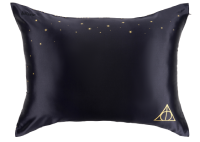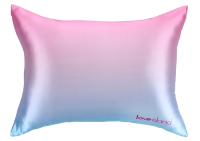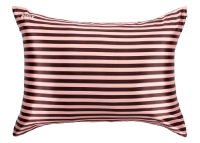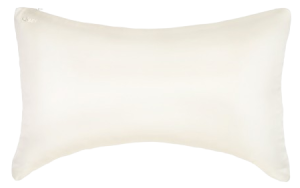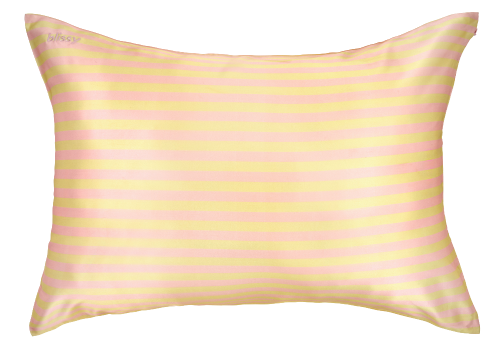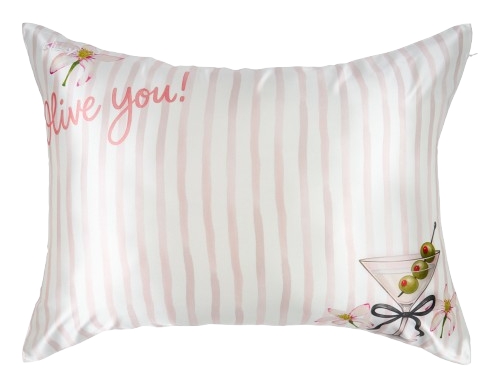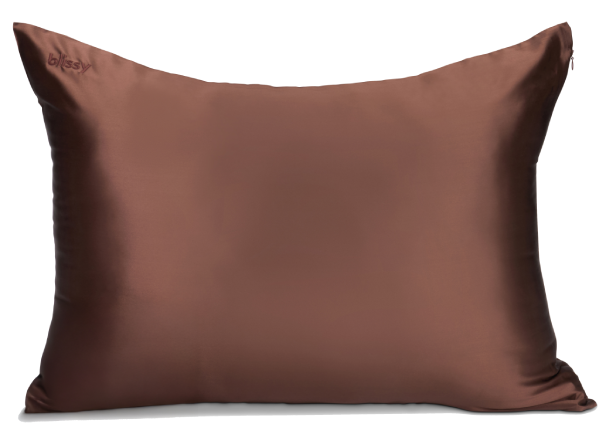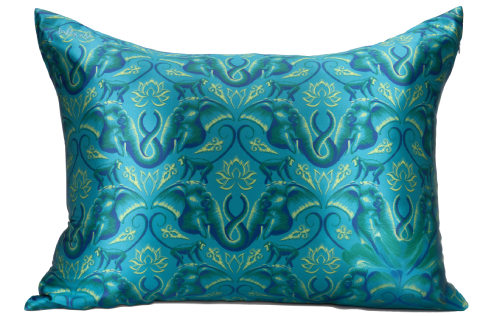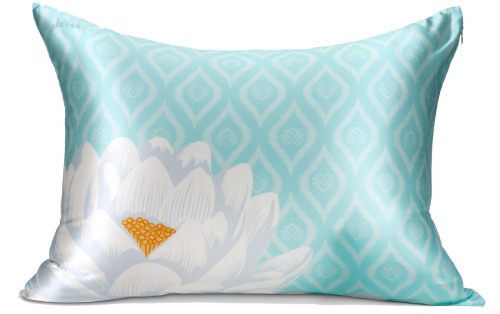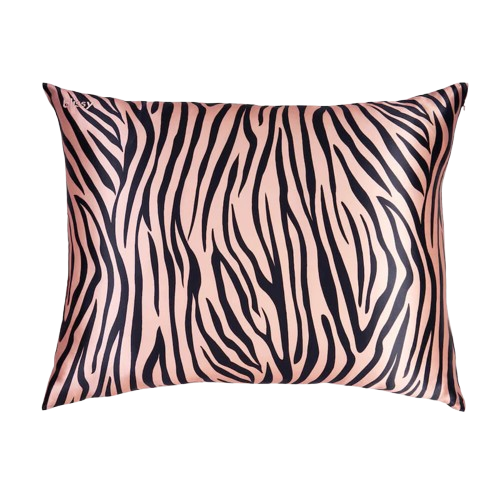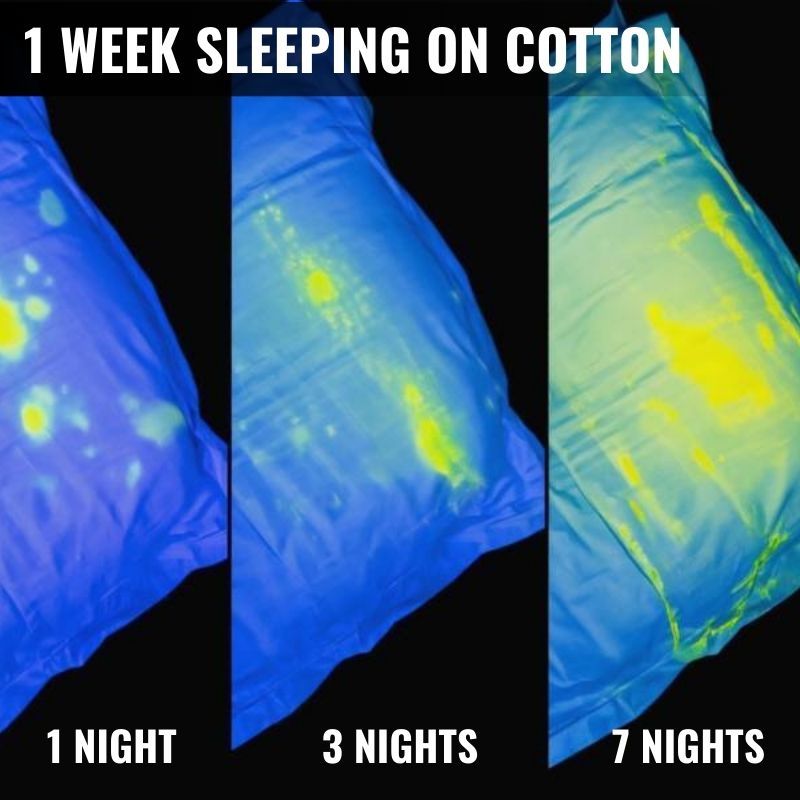Silk bonnets are the best choice for protecting hair while sleeping because they reduce friction, retain moisture, and prevent breakage better than satin. Unlike satin, which is often made from synthetic fibers, silk is a natural material that helps maintain hair health.
This makes silk bonnets ideal for curly, thick, or delicate hair, as well as for preserving hair extensions.
Both satin and silk are smoother than cotton, but silk provides superior hydration and protection. Below, we break down the key differences to help you choose the best option
What is the best silk bonnet for sleeping?
The best silk bonnet for sleep is one made of 100% pure mulberry silk. Silk bonnets reduce friction, prevent breakage, and retain moisture better than satin or cotton. For superior quality, look for OEKO-TEX® certified 22-momme silk, like the Blissy Bonnet.
What’s the Difference Between a Satin and Silk Bonnet for Sleeping?
A silk bonnet is better for sleeping than a satin bonnet because it reduces friction, retains moisture, and prevents breakage more effectively. Unlike satin, which is often made from synthetic fibers, silk is a natural material that nourishes and protects hair overnight.
Hair bonnets come in a variety of materials, each offering unique benefits for your hair. The most common materials are silk, satin, and cotton.
Silk bonnets
Renowned for their ultra-smooth, soft, and luxurious feel, making them a top choice for hair care enthusiasts. They are particularly effective in reducing friction, which helps to maintain your hair’s natural moisture and prevent frizz and breakage.
Satin bonnets
While rougher than silk and not breathable, satin bonnets still offer a smoother touch on your hair than cotton. They are a cheaper option and can help reduce friction better than cotton. However, they do not provide the same level of hydration and protection as silk bonnets.
Cotton bonnets
Cotton bonnets are breathable but they can absorb your hair’s natural oils, leading to dryness and frizz.
Silk vs Satin vs Cotton Bonnets: Sleep Protection Comparison
| Bonnet Type | Friction Reduction | Moisture Retention | Breathability | Hair Protection | Price |
|---|---|---|---|---|---|
| Silk | High | High | Moderate | Excellent | Higher |
| Satin | Medium | Low | Low | Good | Lower |
| Cotton | Low | Very Low | High | Poor | Lower |
For optimal hair health, silk bonnets are the superior choice, offering a perfect blend of smoothness, moisture retention, and durability.

Material and Feel: What’s the Difference Between Satin and Silk Bonnets?
Silk bonnets are made from natural fibers, offering a luxuriously smooth and breathable feel, while satin bonnets are typically made from synthetic materials like polyester or rayon.
Although both appear smooth, silk provides a softer, more lightweight texture that helps reduce friction and hair breakage. Satin, while still smoother than cotton, is less breathable and can trap heat, making it less ideal for sensitive scalps.
Want to know which bonnet is best for your hair? Let’s compare their benefits.
Satin hair bonnets
Satin hair bonnets are crafted from synthetic materials, like polyester, rayon, nylon, and other fabrics. Sometimes these fabrics are treated with harsh dyes and toxic chemicals.
Satin fabric protects hair better than cotton since there's less friction, but it's still rougher than silk and doesn't have the same hydrating qualities. Over time, your tresses won't be as protected from hair damage, breakage, and frizz.
Plus, the fabric of a satin sleep cap is less durable. Although they're cheaper, you'll have to replace them more often.
Silk hair bonnets
Silk hair bonnets are crafted purely from ultra-soft, smooth, natural fiber. High-quality silk bonnets, like Blissy's, are also OEKO-TEX Certified, which means they're safe and non-toxic. Silk fabric applies very little friction to hair strands. In fact, silk creates 43% less friction than cotton, which means you can say goodbye to frizz!
Silk bonnets may have a higher price point, but they’re worth the investment. One silk bonnet can last up to 10 years if properly cared for.
To maintain the quality and longevity of your silk bonnet, it is recommended to hand wash it using mild detergent in cold water. After washing, hang dry the bonnet to ensure it remains in excellent condition. (Click here for a more detailed silk bonnet care guide.)
Further Reading:
What are the pros and cons of silk and satin bonnets for hair?
Satin and silk bonnets offer varying degrees of benefits. But:
Overall, silk is superior. Wearers experience dramatically improved hair health, hydration, and frizz control.
Let's discuss the pros and cons of a satin vs silk bonnet for hair health.

Satin pros and cons:
-
Pro: Satin reduces friction on hair strands, leading to less frizz, breakage, and damage.
-
Pro: Satin offers a better choice for retaining hair moisture than cotton and other rough fabric weaves. It can also help preserve your hairstyle.
-
Con: Synthetic satin bonnets are not as breathable as their silk counterparts. This makes them a poor choice for hot sleepers and those with sensitive skin.
Silk pros and cons:
-
Pro: Silk creates even less friction than satin, allowing for superior hair protection and appearance.
-
Pro: Silk bonnets have the smoothest fabric texture and weave. This helps improve moisture retention. Plus, silk bonnets keep hairstyles intact for longer.
-
Pro: Silk is breathable. It's naturally moisture-wicking and hypoallergenic. This makes it ideal for those with wavy or curly hair and delicate skin.
-
Con: Silk costs more than other materials, like cheaply made synthetic satin. But most users say the investment is worth it.
People with any hair type will benefit from wearing a silk or satin bonnet—although you will gain the most from a silk bonnet.
The adjustable features of silk bonnets allow for a tight fit, preventing the bonnet from slipping off during the night and ensuring effective hair protection. An adjustable bonnet can enhance comfort and ensure a secure fit, preventing the bonnet from slipping off during sleep.
To those with textured hair types: it’s highly recommended that you skip satin entirely and go for a silk cap! Curls are more prone to dryness and frizz—we promise, your curly hair will thank you.
Silk Bonnet vs Satin: Final Verdict for Sleep & Hair Health
- Hypoallergenic & Skin-Friendly Silk is hypoallergenic, making it ideal for sensitive scalps and skin.
- Moisture-Wicking & Breathable Silk keeps your scalp cool and comfortable while helping prevent frizz—especially in warmer weather.
- Locks in Natural Moisture Unlike satin or cotton, silk won’t absorb your hair’s natural oils. This keeps hair hydrated and glossy.
- Minimizes Friction & Breakage Silk reduces tugging, knots, and split ends—helping preserve your style and enhance your hair’s natural texture.
Who Should Use a Silk Bonnet vs. Satin Bonnet
Best for Silk Bonnets
- Curly or long hair types (3A–4C) prone to frizz and breakage
- People focused on scalp and hair health or with sensitive skin
- Those seeking moisture retention and smoother, shiny styles
- Hot sleepers—silk is more breathable than polyester
- Users who need a bonnet that stays on—many include adjustable straps or an elastic band
- Fans of beauty tools made from Oeko-Tex certified mulberry silk
Best for Satin Bonnets
- Budget-conscious shoppers looking for a more affordable option
- Casual wear or backup sleep caps and wraps
- Straight or low-maintenance hair needing basic friction reduction
- People who don’t mind synthetic materials with less breathability
- Good choice for lounging or keeping short styles in shape
What Is the Best Silk Bonnet for Sleep?

The Blissy Bonnet is one of the best silk hair bonnets. Our bonnet is crafted from 100% pure mulberry silk of the finest quality. Our silk bonnet with enhance your nightly healthy hair care routine in a major way. Use it to prevent hair breakage, fight frizz, add shine, reduce dryness, and maintain your style.
Wearing a Blissy Bonnet feels ultra-comfortable and pampering. And better yet—it naturally nourishes and conditions hair while you sleep. This pure silk turban locks in your hair's natural oils and stops bedhead in its tracks, leading to beautiful, glossy hair each morning!
Quick fact: Mulberry silk has the smoothest texture of all silk types and is highly sought after for both beauty and luxury accessories.
Why the Blissy Bonnet is the Best Silk Bonnet (and Which Style Fits You)

Made from 22-momme, Grade 6A mulberry silk, every Blissy Bonnet is OEKO-TEX® certified and skin friendly. The natural silk fibers help reduce friction, support moisture balance, and are gentle on curls and delicate edges.
The Blissy's signature turban-style bonnet comes in two sizes—Regular and Large—fit comfortably for fine hair, thick natural curls, locs, braids, and extensions.
But now, there are three more new Blissy Bonnet styles to choose from!
Meet the new lineup
-
Halo Bonnet – A sleek, everyday silk hair wrap for short to shoulder-length styles. Minimal bulk, breathable, and stays put while you sleep. Great for fine or medium hair and protective styles.
✨ Shop Halo Bonnets -
Bow Bonnet – Our chic, dress-it-up option. Same glide-smooth silk with a soft bow detail for a polished look that can transition into your daily routine. Ideal for straight, wavy, and curly hair that wants style + protection.
✨ Shop Bow Bonnets -
Cascade Bonnet – Extra-length protection for waist-length hair, box braids, twists, or extensions. The elongated design shields lengths and preserves definition. Best for thick curls, braids, and extra-long hair.
✨ Shop Cascade Bonnets
Blissy offers nearly 30 colors and patterns—from Pink to Tiger—so you can sleep in silk and still match your mood. You can also match your bonnet to your pillowcase with over 90 styles to choose from!
Zero-fuss fit: Thanks to a soft, secure elastic band, Blissy's bonnets fit comfortably—no adjustable straps required. Just slip on your bonnet and unwind.
Blissy Bonnet Style Picker Guide
|
Hair length/type |
Best match |
|---|---|
|
Short–shoulder, fine/medium |
Halo Bonnet or Classic Bonnet (Regular) |
|
Shoulder–mid-back, all textures |
Classic Bonnet (Regular/Large) or Bow Bonnet |
|
Thick/voluminous curls & coils |
|
|
Long/waist-length hair, braids, twists, extensions |
|
|
Low-bulk, sleek fit for nightly wear |
|
|
Style-forward / gift-ready look |
Blissy Bonnets come in size regular and large to accommodate all hair lengths and volumes. You can comfortably wear the Blissy Bonnet whether you have fine , thick natural curls, locs, braids, or hair extensions.
Dream of staying stylish even when you're asleep? Our bonnets can complement any PJ set! The Classic Bonnet is available in over 3 dozen colors and pattern choices, from Pink to Tiger
And forget fussing with your hair wrap each night. Due to their elastic band length and secure fit, our bonnets don't require adjustable straps. No need to hassle with adjustments—just slip on your Blissy Bonnet and unwind.
Plus, Blissy Bonnets are low-maintenance—they're machine-washable. Click here for our detailed silk care guide.
Blissy Bonnets are chic, comfortable, lightweight, and durable. Look elegant while you sleep and wake up to smooth, shiny hair!
Further Reading:
In Summary: Why the Blissy Bonnet Consistently Outperforms Satin
Silk bonnets are better for sleeping than satin because they naturally retain moisture, reduce friction, and prevent hair breakage, while satin, often made from synthetic fibers, lacks the same breathability and hydration benefits.
Silk hair bonnets have numerous advantages over satin bonnets.

Silk bonnets:
-
Are crafted from natural fiber
-
Offer enhanced moisture and shine, less frizz, and fewer tangles and split ends
-
Keep hairstyles intact for an extended period
-
Are ultra-soft, smooth, and durable
-
Have hypoallergenic properties
-
Are breathable and moisture-wicking
If you're ready for a premium hair care experience, forget satin—indulge in our luxurious silk bonnet.
Key takeaways:
-
Silk bonnets are superior to satin for hair protection and health.
-
Silk reduces friction, retains moisture, and prevents frizz better than satin.
-
Satin bonnets are typically synthetic, while silk is a natural fiber.
-
Blissy Bonnets offer high-quality mulberry silk for optimal hair care.



